Hvor det begynder:Unge sultne græshopper vokser i Somalia
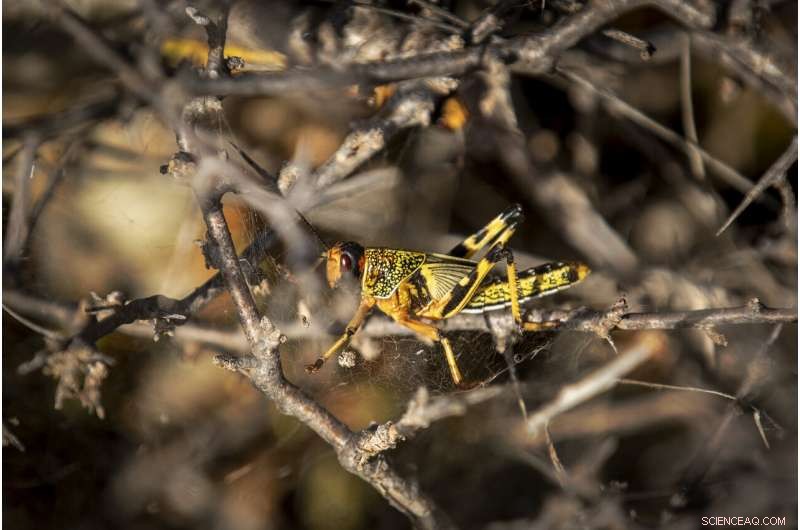
På dette billede taget tirsdag d. 4. februar, 2020, en ung ørkengræshoppe, der endnu ikke har fået vinger, sidder fast i et edderkoppespind på en tornet busk i ørkenen nær Garowe, i den semi-autonome Puntland-region i Somalia. Ørkengræshopperne i dette tørre område i det nordlige Somalia ser mindre ildevarslende ud end de milliardstore sværme, der inficerer Østafrika, men de hoppende unge græshopper er den næste bølge i udbruddet, der truer mere end 10 millioner mennesker i hele regionen med en alvorlig sultkrise. (AP Photo/Ben Curtis)
Ved første øjekast, ørkengræshopperne i denne tørre del af det nordlige Somalia ser mindre ildevarslende ud end de milliardstore sværme, der angriber Østafrika i det værste udbrud, nogle steder har set i 70 år.
Men deres tid kommer.
Lille og vingeløs, de hoppende unge græshopper er den næste bølge i udbruddet, der truer mere end 10 millioner mennesker i hele regionen med en alvorlig sultkrise.
Og de vokser op på et af de mest utilgængelige steder på kloden. Store dele af Somalia syd for denne semi-autonome Puntland-region er truet, eller holdes af, den al-Qaida-forbundne al-Shabab ekstremistgruppe. Det gør det vanskeligt eller umuligt at udføre sprøjtning fra luften af græshopperne, som eksperter siger er den eneste effektive bekæmpelse.
Somalia har erklæret udbruddet for en national nødsituation. På tværs af regionen, det har potentialet til "at være den mest ødelæggende græshoppeplag i nogen af vores levende minder, hvis vi ikke reducerer problemet hurtigere, end vi gør i øjeblikket, " sagde FN's humanitære chef Mark Lowcock.
Mens en bevæbnet somalisk politimand stod ved siden af, eksperter gik torsdag over det tørre land og kravlede med de unge græshopper og forklarede truslen, der ville komme, hvis verden ikke handler lige nu.
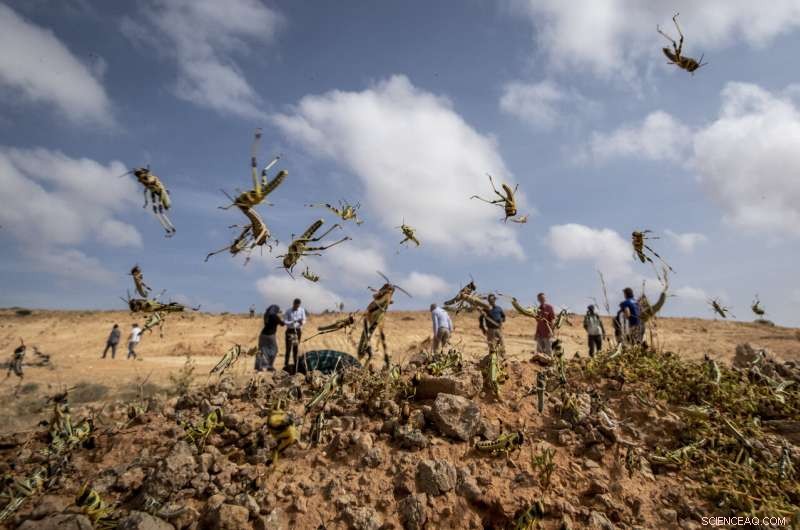
På dette billede taget onsdag d. 5. februar, 2020, unge ørkengræshopper, der endnu ikke har fået vinger, hopper i luften, når de nærmes, som en besøgende delegation fra Fødevare- og Landbrugsorganisationen (FAO) observerer dem, i ørkenen nær Garowe, i den semi-autonome Puntland-region i Somalia. Ørkengræshopperne i dette tørre område i det nordlige Somalia ser mindre ildevarslende ud end de milliardstore sværme, der inficerer Østafrika, men de hoppende unge græshopper er den næste bølge i udbruddet, der truer mere end 10 millioner mennesker i hele regionen med en alvorlig sultkrise. (AP Photo/Ben Curtis)
"Verden skal vide, at det er her det hele begynder, " sagde Alberto Trillo Barca, en talsmand for FN's fødevare- og landbrugsorganisation. "I de næste tre eller fire uger, disse nymfer, som vi kalder dem, vil udvikle vinger."
Derefter forventes de at tage af sted til nabolandene Kenya og Etiopien, hvor en håndfuld fly, der sprøjter pesticid, kun kan gøre så meget, hvis sådanne sværme bliver ved med at ankomme.
Klimaeksperter har peget på usædvanlig kraftig regn, hjulpet af en kraftig cyklon ud for Somalia i december, som en væsentlig faktor i udbruddet. Græshopperne blev båret ind af stormens vinde fra Den Arabiske Halvø og dele videre, og nu lever de af Somalias friske vegetation.
Med mere regn ventes i regionen i de kommende uger, antallet af græshopper, hvis det ikke kontrolleres, kan vokse med op til 500 gange i juni, når der forventes mere tørt vejr.
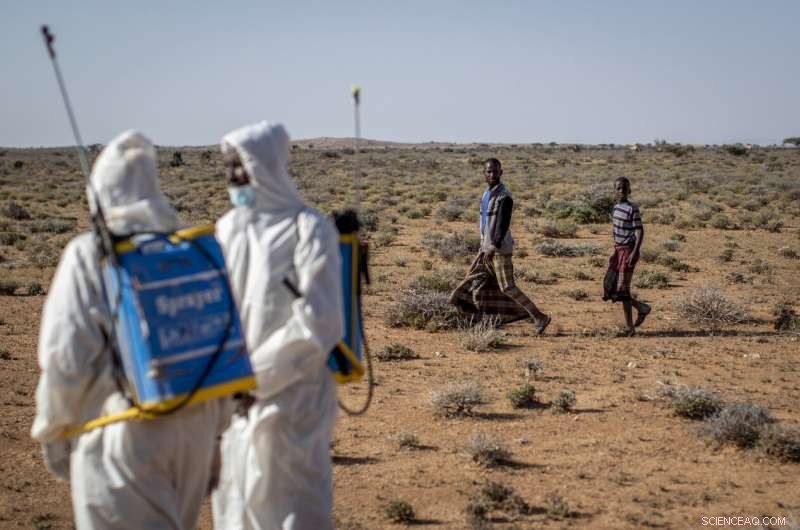
På dette billede taget tirsdag d. 4. februar, 2020, Somaliske sprøjter til skadedyrsbekæmpelse demonstrerer deres arbejde på de tornede buske i ørkenen, som er ynglepladsen for ørkengræshopper for en besøgende delegation af embedsmænd fra det somaliske ministerium og eksperter fra Fødevare- og Landbrugsorganisationen (FAO), i ørkenen nær Garowe, i den semi-autonome Puntland-region i Somalia. Ørkengræshopperne i dette tørre område i det nordlige Somalia ser mindre ildevarslende ud end de milliardstore sværme, der inficerer Østafrika, men de hoppende unge græshopper er den næste bølge i udbruddet, der truer mere end 10 millioner mennesker i hele regionen med en alvorlig sultkrise. (AP Photo/Ben Curtis)
Men det tørre vejr er ikke nødvendigvis løsningen, sagde Dominique Burgeon, FAO's beredskabs- og resiliensdirektør.
Tætheden af græshopperne er nu så høj, at selv normal fugt kan føre til endnu en generation, han sagde.
"Vi kan ikke tro på, at Moder Natur kan løse det, " forklarede han.
Uden nok sprøjtning til at stoppe sværmene, det allerede bekymrende udbrud kan blive til en pest, "og når du har en pest, det tager år at kontrollere, " han sagde.
I modsætning til det fejende syn, nogle få maskerede arbejdere med hvide beskyttelsesdragter og pesticidbeholdere spændt på ryggen stod i den kamelkrydsede somaliske ørken, sprøjte de tusindvis af græshopper, der klamrer sig til tornede buske.
Verdens skiftende klima medfører risiko for, at flere cykloner kommer ind fra det opvarmende Indiske Ocean ud for Østafrika, siger klimaeksperter. Med det, sandsynligheden for yderligere græshoppeudbrud vokser.
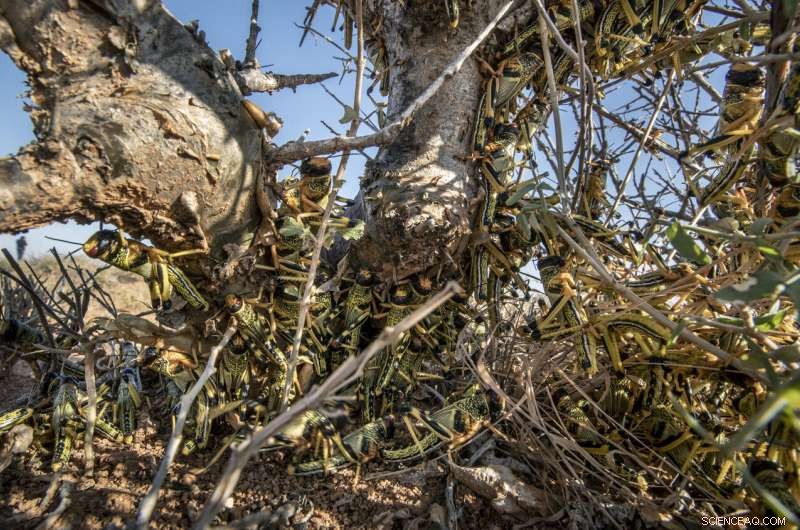
På dette billede taget tirsdag d. 4. februar, 2020, unge ørkengræshopper, der endnu ikke har fået vinger, stimler sammen på en tornet busk i ørkenen nær Garowe, i den semi-autonome Puntland-region i Somalia. Ørkengræshopperne i dette tørre område i det nordlige Somalia ser mindre ildevarslende ud end de milliardstore sværme, der inficerer Østafrika, men de hoppende unge græshopper er den næste bølge i udbruddet, der truer mere end 10 millioner mennesker i hele regionen med en alvorlig sultkrise. (AP Photo/Ben Curtis)
Den slags nye normale, " sagde Burgeon.
Og det betyder Kenya, Etiopien og andre østafrikanske lande, der sjældent ser sådanne udbrud og stort set var uforberedte på dette, kunne slutte sig til "frontlinjelande" i dele af Vestafrika og Mellemøsten, siger eksperter. Those countries have well-trained monitoring and prevention systems in place for more frequent locust outbreaks.
The FAO has asked international donors to give $76 million immediately to help control this outbreak. So far $19 million is in hand, Burgeon said.
"The biggest challenge is the scale of the breeding, as you can see all around us, " Barca said. These locusts, han sagde, will be migrating to southern Somalia and parts of Kenya and Ethiopia just as crops are germinating there.
"If at that time there are huge quantities of locusts around, it will have a devastating impact on the crops, " Burgeon said.
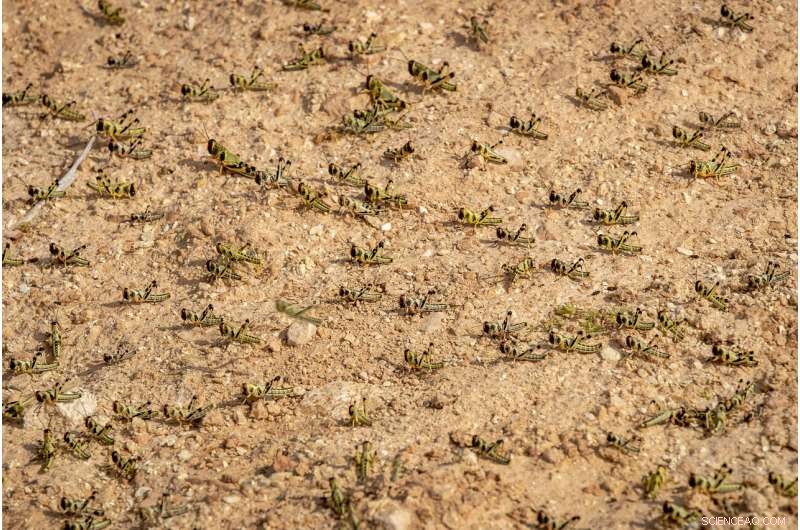
På dette billede taget onsdag d. Feb. 5, 2020, young desert locusts that have not yet grown wings cover the ground in the desert near Garowe, in the semi-autonomous Puntland region of Somalia. The desert locusts in this arid patch of northern Somalia look less ominous than the billion-member swarms infesting East Africa, but the hopping young locusts are the next wave in the outbreak that threatens more than 10 million people across the region with a severe hunger crisis. (AP Photo/Ben Curtis)
Other East African countries including Uganda, Sydsudan, Eritrea and Djibouti are also at risk, Burgeon said. Millions of people in some of these places are already facing hunger in the wake of civil war or more common challenges such as poverty.
Here in rural Somalia, where about 50% of the people depend on animals for their livelihoods, the locusts are eating the pasturage. The animals weaken, their milk decreases and small children, who depend on the milk to survive, suffer skyrocketing malnutrition, the experts said.
Those fighting the locust outbreak may try to negotiate with Somalia's extremist fighters to allow spraying in rural areas where they are active, Burgeon said. Already emergency workers are going in where they can.
In a few weeks the young locusts will shed their skin, said Keith Cressman, a senior locust forecasting officer with the FAO.
-
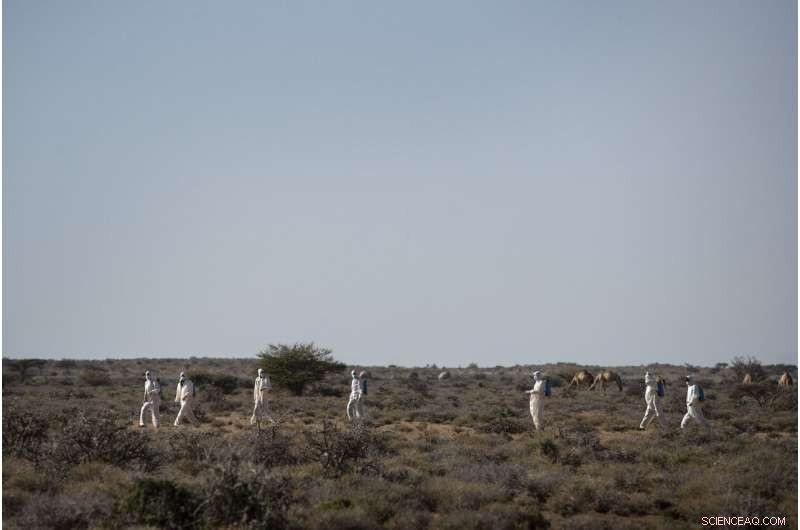
In this photo taken Tuesday, Feb. 4, 2020, Somali pest-control sprayers demonstrate their work on the thorny bushes in the desert that is the breeding ground of desert locusts for a visiting delegation of Somali ministry officials and experts from the Food and Agriculture Organization (FAO), in the desert near Garowe, in the semi-autonomous Puntland region of Somalia. The desert locusts in this arid patch of northern Somalia look less ominous than the billion-member swarms infesting East Africa, but the hopping young locusts are the next wave in the outbreak that threatens more than 10 million people across the region with a severe hunger crisis. (AP Photo/Ben Curtis)
-
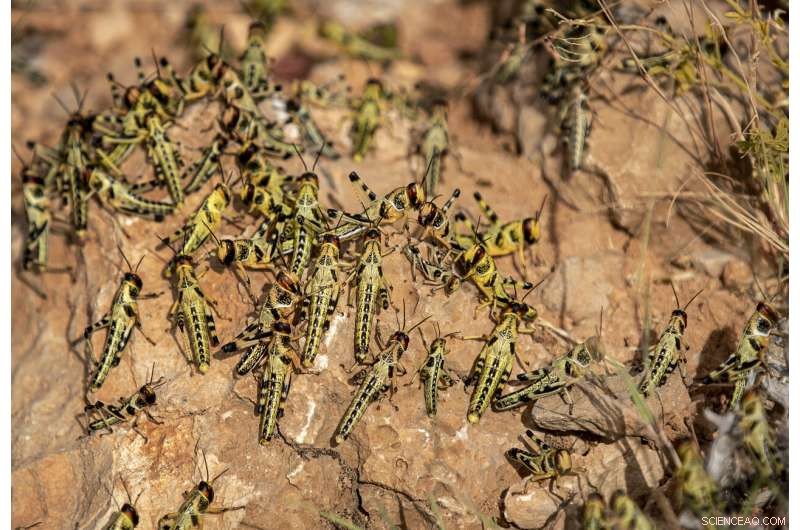
På dette billede taget onsdag d. Feb. 5, 2020, young desert locusts that have not yet grown wings crowd together on a rock in the desert near Garowe, in the semi-autonomous Puntland region of Somalia. The desert locusts in this arid patch of northern Somalia look less ominous than the billion-member swarms infesting East Africa, but the hopping young locusts are the next wave in the outbreak that threatens more than 10 million people across the region with a severe hunger crisis. (AP Photo/Ben Curtis)
-
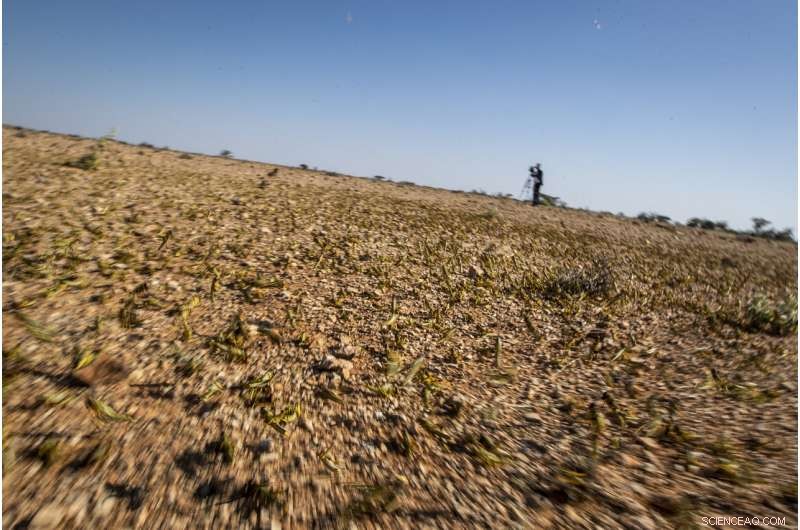
In this photo taken Tuesday, Feb. 4, 2020, young desert locusts that have not yet grown wings jump in the air as they are approached in the desert near Garowe, in the semi-autonomous Puntland region of Somalia. The desert locusts in this arid patch of northern Somalia look less ominous than the billion-member swarms infesting East Africa, but the hopping young locusts are the next wave in the outbreak that threatens more than 10 million people across the region with a severe hunger crisis. (AP Photo/Ben Curtis)
-
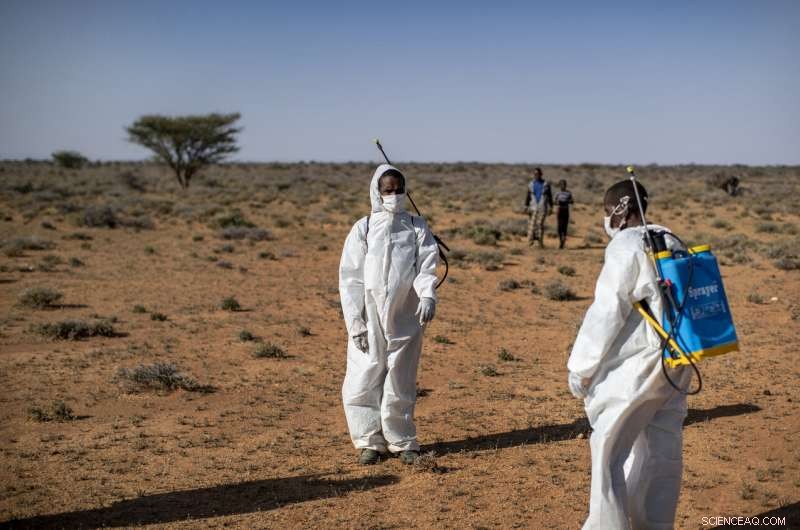
In this photo taken Tuesday, Feb. 4, 2020, Somali pest-control sprayers demonstrate their work on the thorny bushes in the desert that is the breeding ground of desert locusts for a visiting delegation of Somali ministry officials and experts from the Food and Agriculture Organization (FAO), in the desert near Garowe, in the semi-autonomous Puntland region of Somalia. The desert locusts in this arid patch of northern Somalia look less ominous than the billion-member swarms infesting East Africa, but the hopping young locusts are the next wave in the outbreak that threatens more than 10 million people across the region with a severe hunger crisis. (AP Photo/Ben Curtis)
-
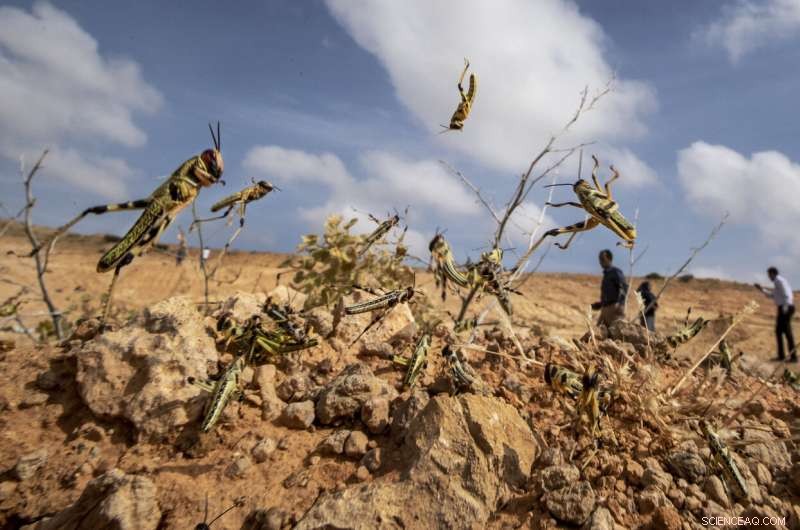
På dette billede taget onsdag d. Feb. 5, 2020, young desert locusts that have not yet grown wings jump in the air as they are approached, as a visiting delegation from the Food and Agriculture Organization (FAO) observes them, in the desert near Garowe, in the semi-autonomous Puntland region of Somalia. The desert locusts in this arid patch of northern Somalia look less ominous than the billion-member swarms infesting East Africa, but the hopping young locusts are the next wave in the outbreak that threatens more than 10 million people across the region with a severe hunger crisis. (AP Photo/Ben Curtis)
-
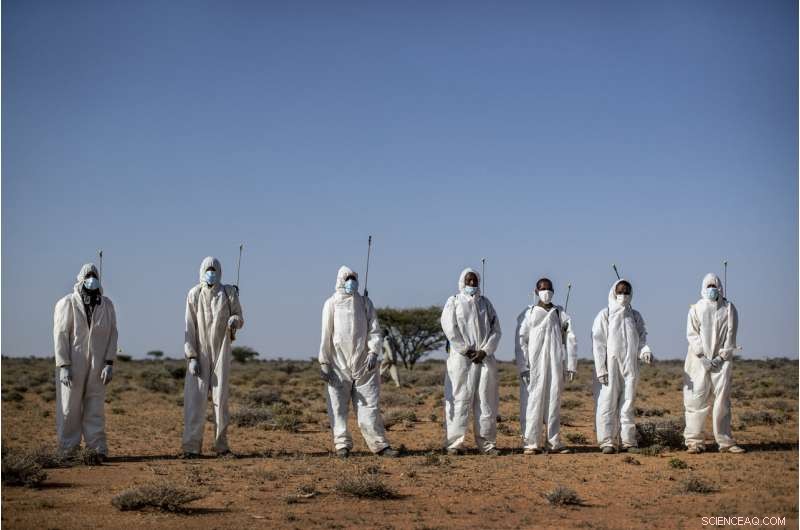
In this photo taken Tuesday, Feb. 4, 2020, pest-control sprayers demonstrate their work on the thorny bushes in the desert that is the breeding ground of desert locusts for a visiting delegation of Somali ministry officials and experts from the Food and Agriculture Organization (FAO), in the desert near Garowe, in the semi-autonomous Puntland region of Somalia. The desert locusts in this arid patch of northern Somalia look less ominous than the billion-member swarms infesting East Africa, but the hopping young locusts are the next wave in the outbreak that threatens more than 10 million people across the region with a severe hunger crisis. (AP Photo/Ben Curtis)
-
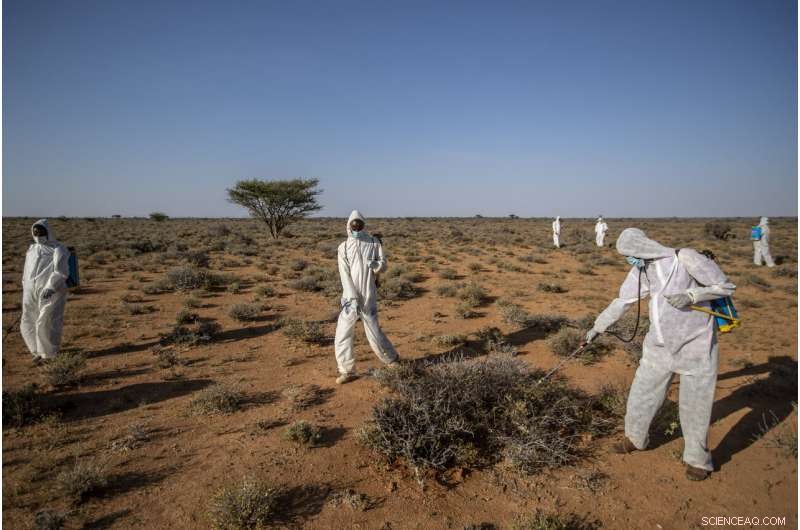
In this photo taken Tuesday, Feb. 4, 2020, pest-control sprayers demonstrate their work on the thorny bushes in the desert that is the breeding ground of desert locusts for a visiting delegation of Somali ministry officials and experts from the Food and Agriculture Organization (FAO), in the desert near Garowe, in the semi-autonomous Puntland region of Somalia. The desert locusts in this arid patch of northern Somalia look less ominous than the billion-member swarms infesting East Africa, but the hopping young locusts are the next wave in the outbreak that threatens more than 10 million people across the region with a severe hunger crisis. (AP Photo/Ben Curtis)
-
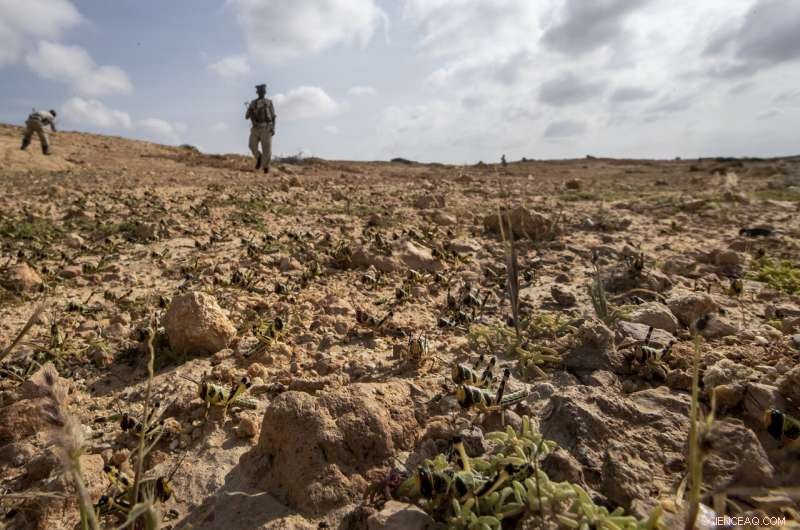
På dette billede taget onsdag d. Feb. 5, 2020, a policeman looks at young desert locusts that have not yet grown wings covering the ground in the desert near Garowe, in the semi-autonomous Puntland region of Somalia. The desert locusts in this arid patch of northern Somalia look less ominous than the billion-member swarms infesting East Africa, but the hopping young locusts are the next wave in the outbreak that threatens more than 10 million people across the region with a severe hunger crisis. (AP Photo/Ben Curtis)
-
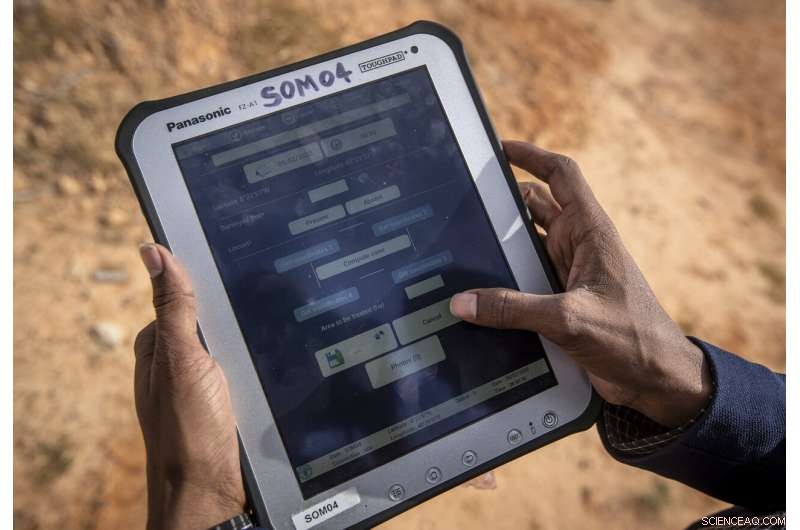
På dette billede taget onsdag d. Feb. 5, 2020, an official from the Food and Agriculture Organization (FAO) demonstrates the "eLocust3" software used to record and track the location and movements of locusts using GPS and transmit the data via satellite, in the desert near Garowe, in the semi-autonomous Puntland region of Somalia. The desert locusts in this arid patch of northern Somalia look less ominous than the billion-member swarms infesting East Africa, but the hopping young locusts are the next wave in the outbreak that threatens more than 10 million people across the region with a severe hunger crisis. (AP Photo/Ben Curtis)
-

På dette billede taget onsdag d. Feb. 5, 2020, Dominique Burgeon, centrum, Director of the Emergency and Resilience Division of the Food and Agriculture Organization (FAO) and Keith Cressman, ret, Senior Locust Forecasting Officer for FAO, walk in the desert between Garowe and Qardho, in the semi-autonomous Puntland region of Somalia. The desert locusts in this arid patch of northern Somalia look less ominous than the billion-member swarms infesting East Africa, but the hopping young locusts are the next wave in the outbreak that threatens more than 10 million people across the region with a severe hunger crisis. (AP Photo/Ben Curtis)
"It takes a few days to warm up their wings, " he said. Some test flights follow and they're on the move.
The locusts at that stage are bright pink and in their most voracious state, like "very hungry teenagers, " Cressman said. By now, many people in Kenya and Ethiopia know them well.
After a month or so, the locusts will be mature adults, ready to reproduce.
Soon after copulating and laying eggs the locusts will die, "but their progeny will be hatching, " Cressman said. "And we have another generation of locusts to contend with, with about another 20-fold increase."
© 2020 The Associated Press. Alle rettigheder forbeholdes.
Sidste artikelArktisk issmeltning ændrer havstrømme
Næste artikelApps til at dele mad, der søger at hjælpe miljøet
 Varme artikler
Varme artikler
-
 Drivhusgasemissioner fra international skibsfart stigerKredit:papazachariasa fra Pixabay Nationale regeringer har et langt større ansvar for emissioner fra skibsfart end tidligere anslået, finder ny UCL-ledet forskning. Udgivet i dag, Den Internation
Drivhusgasemissioner fra international skibsfart stigerKredit:papazachariasa fra Pixabay Nationale regeringer har et langt større ansvar for emissioner fra skibsfart end tidligere anslået, finder ny UCL-ledet forskning. Udgivet i dag, Den Internation -
 Er klimaforskere for forsigtige, når de forbinder ekstremt vejr med klimaforandringer?Offentligheden forventer at modtage avanceret advarsel om farligt vejr, såsom tornadoer og vinterstorme. Dette foto viser en tornado i Prospect Valley, Colorado, den 19. juni, 2018. Kredit:Eric Meola
Er klimaforskere for forsigtige, når de forbinder ekstremt vejr med klimaforandringer?Offentligheden forventer at modtage avanceret advarsel om farligt vejr, såsom tornadoer og vinterstorme. Dette foto viser en tornado i Prospect Valley, Colorado, den 19. juni, 2018. Kredit:Eric Meola -
 Livets oprindelse:nye beviser, at de første celler kunne være dannet på bunden af havetCelle membran, en forudsætning for livet. Kredit:Kateryna Kon/Shutterstock Hvor kom livet fra? I de seneste år, mange videnskabsmænd har skiftet fra at foretrække en ursuppe i vandbassiner til hyd
Livets oprindelse:nye beviser, at de første celler kunne være dannet på bunden af havetCelle membran, en forudsætning for livet. Kredit:Kateryna Kon/Shutterstock Hvor kom livet fra? I de seneste år, mange videnskabsmænd har skiftet fra at foretrække en ursuppe i vandbassiner til hyd -
 Bestemmelse af erosionshastigheder via malingMalerier på klipper i en kløft i de schweiziske alper hjælper med at overvåge erosionshastigheden. Kredit:Alexander R. Beer/ETH Zürich I en ny forundersøgelse, et schweizisk-tysk hold af videnskab
Bestemmelse af erosionshastigheder via malingMalerier på klipper i en kløft i de schweiziske alper hjælper med at overvåge erosionshastigheden. Kredit:Alexander R. Beer/ETH Zürich I en ny forundersøgelse, et schweizisk-tysk hold af videnskab
- Variationerne i nedbøren på Nordpolen vil stige kraftigt
- Løftet om at bruge WhatsApp til lavteknologisk fjernundervisning
- VERITAS leverer kritisk brik til neutrino -opdagelsespuslespil
- Med subsidier til fossile brændstoffer, menneskeheden investerer i egen undergang:FN-chef
- Zinkstannat nanostrukturer:Dyrkning af en yderst nyttig halvleder
- Global opvarmning på 1,5 C eller 2 C:Den nedre grænse ville reducere risikoen for oversvømmelser


